SomnusNooze
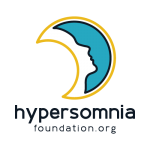 Happy March! Did you know that March is Women’s History Month? While you are celebrating all the amazing women throughout history this entire month, don’t forget that there are also lots of other fun (and offbeat) celebrations in March, including National Pi Day (3.14 or March 14), World Sleep Day (March 15), St. Patrick’s Day (March 17), International Earth Day (March 20), the first day of Spring (March 20), Make Up Your Own Holiday day (March 26), and National Take a Walk in the Park day (March 30). Given all these celebrations, you might not have much time to keep up with the news about sleep disorders. So we at the Hypersomnia Foundation are here to help, by summarizing the recent news in our newest “In Case You Missed It!”. This month we highlight some of the most important news and social media posts about the HF, idiopathic hypersomnia, and related sleep disorders from the past 4 weeks. From raising IH awareness on World Sleep Day to introducing two new members of our HF Board to announcing additional details about our June Educational Meeting in Seattle to numerous research updates, we have you covered!
Happy March! Did you know that March is Women’s History Month? While you are celebrating all the amazing women throughout history this entire month, don’t forget that there are also lots of other fun (and offbeat) celebrations in March, including National Pi Day (3.14 or March 14), World Sleep Day (March 15), St. Patrick’s Day (March 17), International Earth Day (March 20), the first day of Spring (March 20), Make Up Your Own Holiday day (March 26), and National Take a Walk in the Park day (March 30). Given all these celebrations, you might not have much time to keep up with the news about sleep disorders. So we at the Hypersomnia Foundation are here to help, by summarizing the recent news in our newest “In Case You Missed It!”. This month we highlight some of the most important news and social media posts about the HF, idiopathic hypersomnia, and related sleep disorders from the past 4 weeks. From raising IH awareness on World Sleep Day to introducing two new members of our HF Board to announcing additional details about our June Educational Meeting in Seattle to numerous research updates, we have you covered!
WORLD SLEEP DAY MARCH 15
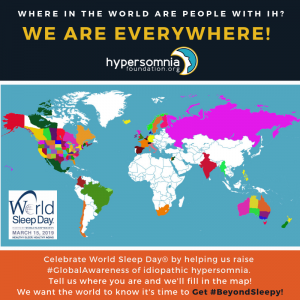 Thank you for helping us spread Global Awareness of IH as we celebrated World Sleep Day® on March 15! We asked you to tell us where you are, and the responses have been amazing! Our goal is to help researchers and pharmaceutical companies structure their studies and demonstrate to legislators, in the United States and throughout the world, that the challenge of living with IH is global. Keep your responses coming by telling us where in the world you are via comment on our Facebook post or email at , and help us track the need for worldwide IH support.
Thank you for helping us spread Global Awareness of IH as we celebrated World Sleep Day® on March 15! We asked you to tell us where you are, and the responses have been amazing! Our goal is to help researchers and pharmaceutical companies structure their studies and demonstrate to legislators, in the United States and throughout the world, that the challenge of living with IH is global. Keep your responses coming by telling us where in the world you are via comment on our Facebook post or email at , and help us track the need for worldwide IH support.
Where in the world are people with IH? WE ARE EVERYWHERE!
ANNOUNCING TWO NEW HF BOARD MEMBERS
The Hypersomnia Foundation is proud to announce two new Board members! We are delighted to welcome Sarah Beazley and Lisa Laribee to our Board of Directors. “Sarah and Lisa have long been supporters of the Hypersomnia Foundation, and we are excited to have two individuals with such talent and experience join the Board,” said Diane Powell, HF Chair and CEO.
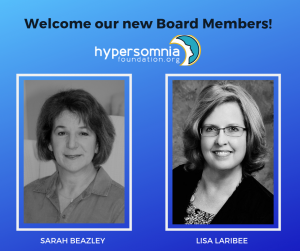 SARAH BEAZLEY is a trained nurse who has worked as an RN in various Pediatric and Neonatal Intensive Care units in Georgia and California. Her background in nursing will significantly help us educate the public and health care providers about IH, and she will serve as a strong advocate for those with IH and related sleep disorders.
SARAH BEAZLEY is a trained nurse who has worked as an RN in various Pediatric and Neonatal Intensive Care units in Georgia and California. Her background in nursing will significantly help us educate the public and health care providers about IH, and she will serve as a strong advocate for those with IH and related sleep disorders.
LISA LARIBEE is a professional fundraiser with over 20 years of experience in writing grants for a variety of health care fields, and currently serves as the Manager of Grants and Foundation Relations for St. Joseph’s Health Foundation. Her years of development expertise will greatly benefit our fundraising efforts for increased research and awareness.
Welcome Sarah and Lisa! Visit our website to learn more about our Board of Directors.
JOIN THE HF FOR AN EDUCATIONAL MEETING IN SEATTLE ON JUNE 29
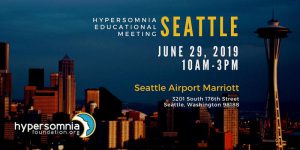 Join us in Seattle on Saturday, June 29, 2019, from 10:00 a.m. – 3:00 p.m. for an HF Educational Meeting. Guest speakers include Dr. David Rye of Emory University and Dr. Flavia Consens of University of Washington / Harborview Medical Center. Representatives from Balance Therapeutics will also provide information about their ongoing Arise2 IH clinical trial. The meeting will be held at the Seattle Airport Marriott on 176th Street, and we have arranged for a discounted room rate. Click HERE to reserve your room now. The cost for the educational event is $25, which includes lunch, and you can register through EventBrite. Look for updates via our social media, SomnusNooze, and our Seattle Event page.
Join us in Seattle on Saturday, June 29, 2019, from 10:00 a.m. – 3:00 p.m. for an HF Educational Meeting. Guest speakers include Dr. David Rye of Emory University and Dr. Flavia Consens of University of Washington / Harborview Medical Center. Representatives from Balance Therapeutics will also provide information about their ongoing Arise2 IH clinical trial. The meeting will be held at the Seattle Airport Marriott on 176th Street, and we have arranged for a discounted room rate. Click HERE to reserve your room now. The cost for the educational event is $25, which includes lunch, and you can register through EventBrite. Look for updates via our social media, SomnusNooze, and our Seattle Event page.
BACLOFEN BRINGS RELIEF TO THOSE WITH EDS
 Baclofen, an inexpensive medication with a known safety profile in all age groups, was found to be effective with adolescent patients with narcolepsy type 1 (NT1) by reducing excessive daytime sleepiness and improving sleep consolidation. To read more in the recent edition of “Neurology Advisor”, click HERE.
Baclofen, an inexpensive medication with a known safety profile in all age groups, was found to be effective with adolescent patients with narcolepsy type 1 (NT1) by reducing excessive daytime sleepiness and improving sleep consolidation. To read more in the recent edition of “Neurology Advisor”, click HERE.
MORE GABA-A RECEPTOR STRUCTURES SOLVED!
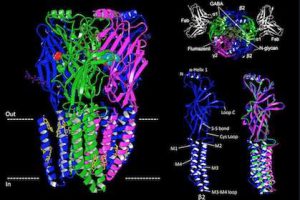 A research team made up of professionals from the US, UK, and the EU have solved some of the structures of GABA-A receptors. (GABA receptors are a class of receptors that respond to the neurotransmitter gamma-aminobutyric acid (GABA), the chief inhibitory compound in the central nervous system. Some well-known drugs that target the GABA-A receptors include benzodiazepines and general anesthetics.) Using single particle cryo-electron microscopy (cryo-EM), the researchers solved the first structure of a GABA-A receptor in a physiological conformation, reconstituted into a lipid bilayer. These researchers also used this cryo-EM technology to solve five structures of the same receptor in complex with various drugs. These structures provide insights into the mechanisms of action of GABA-A receptor-targeting molecules and could provide the basis for future structure-based drug discovery. This research also highlights the emerging opportunities for applying cryo-EM in drug discoveries. Read more HERE.
A research team made up of professionals from the US, UK, and the EU have solved some of the structures of GABA-A receptors. (GABA receptors are a class of receptors that respond to the neurotransmitter gamma-aminobutyric acid (GABA), the chief inhibitory compound in the central nervous system. Some well-known drugs that target the GABA-A receptors include benzodiazepines and general anesthetics.) Using single particle cryo-electron microscopy (cryo-EM), the researchers solved the first structure of a GABA-A receptor in a physiological conformation, reconstituted into a lipid bilayer. These researchers also used this cryo-EM technology to solve five structures of the same receptor in complex with various drugs. These structures provide insights into the mechanisms of action of GABA-A receptor-targeting molecules and could provide the basis for future structure-based drug discovery. This research also highlights the emerging opportunities for applying cryo-EM in drug discoveries. Read more HERE.
IS IH, LIKE NARCOLEPSY, AN AUTOIMMUNE DISORDER?
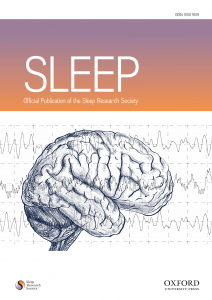 A research team from the University of Muenster in Germany studied the immune mechanisms involved in disorders of excessive sleepiness. The study aimed to identify specific immune profiles in peripheral blood and cerebrospinal fluid in different types of hypersomnolence. The study compared 24 individuals without a sleep disorder to 43 persons with confirmed sleep disorders – 24 with idiopathic hypersomnia, 12 with narcolepsy type 1, and 7 with narcolepsy type 2. Peripheral blood and cerebrospinal fluid were analyzed to distinguish between peripheral and intrathecal immune cells and specific surface markers of T-cells. The results provided evidence that autoimmune-related processes occurred across narcolepsy type 1, narcolepsy type 2, and idiopathic hypersomnia – and correlated with the extent of the sleepiness. This significant correlation of T-cells with higher amounts of excessive daytime sleepiness was found in the NT1 and IH groups, which indicated an association of activated T-cells in the central nervous system with an increase in sleepiness. These findings provided further evidence of a T-cell-mediated autoimmunity not only in NT1, but also in NT2 and IH. Read more HERE.
A research team from the University of Muenster in Germany studied the immune mechanisms involved in disorders of excessive sleepiness. The study aimed to identify specific immune profiles in peripheral blood and cerebrospinal fluid in different types of hypersomnolence. The study compared 24 individuals without a sleep disorder to 43 persons with confirmed sleep disorders – 24 with idiopathic hypersomnia, 12 with narcolepsy type 1, and 7 with narcolepsy type 2. Peripheral blood and cerebrospinal fluid were analyzed to distinguish between peripheral and intrathecal immune cells and specific surface markers of T-cells. The results provided evidence that autoimmune-related processes occurred across narcolepsy type 1, narcolepsy type 2, and idiopathic hypersomnia – and correlated with the extent of the sleepiness. This significant correlation of T-cells with higher amounts of excessive daytime sleepiness was found in the NT1 and IH groups, which indicated an association of activated T-cells in the central nervous system with an increase in sleepiness. These findings provided further evidence of a T-cell-mediated autoimmunity not only in NT1, but also in NT2 and IH. Read more HERE.
MEGA-SIZE VIRTUAL DOCKING LIBRARY POISED TO SPEED DRUG DISCOVERIES
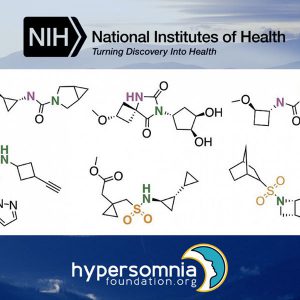 Researchers have launched an ultra-large “virtual” docking library, expected to grow to more than one-billion molecules by next year, making these “make-on-demand” compounds readily available to scientists for chemical biology and drug discovery. Modeling done via computer vastly expedites the process of discovering new treatments, enabling researchers to virtually “see” a molecule docking with its receptor protein — like a ship in its harbor berth or a key in its lock — and predict its pharmacological properties, based on how the molecular structures are predicted to interact. Only candidate molecules that best match the target profile on the computer will be physically made and tested in a wet lab. The larger the virtual library, the better its odds of weeding out inactive “decoy” molecules that could otherwise lead researchers down blind alleys. Funded by the National Institutes of Health, this mega docking library is poised to speed drug discoveries. Read more HERE.
Researchers have launched an ultra-large “virtual” docking library, expected to grow to more than one-billion molecules by next year, making these “make-on-demand” compounds readily available to scientists for chemical biology and drug discovery. Modeling done via computer vastly expedites the process of discovering new treatments, enabling researchers to virtually “see” a molecule docking with its receptor protein — like a ship in its harbor berth or a key in its lock — and predict its pharmacological properties, based on how the molecular structures are predicted to interact. Only candidate molecules that best match the target profile on the computer will be physically made and tested in a wet lab. The larger the virtual library, the better its odds of weeding out inactive “decoy” molecules that could otherwise lead researchers down blind alleys. Funded by the National Institutes of Health, this mega docking library is poised to speed drug discoveries. Read more HERE.
EVER FEEL A LACK OF CONTROL OVER YOUR LIFE?
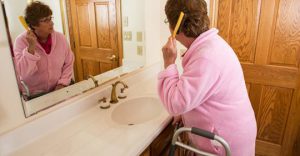 Feeling that we have control over our lives has implications for physical, mental, and emotional well-being, our self-care, and quality of life. Researchers from North Carolina State University have found that sleep, mood, and stress affect two beliefs about having control: perceived competence (an individual’s sense that they can do the things they want to do) and locus of control (an individual’s sense that they are in control of their own lives). Although this study involved older adults, people with IH may also experience these feelings at any age, which is why it’s something to talk about with your health care provider and supporters. Read more about the study in “Sleep Review” magazine HERE.
Feeling that we have control over our lives has implications for physical, mental, and emotional well-being, our self-care, and quality of life. Researchers from North Carolina State University have found that sleep, mood, and stress affect two beliefs about having control: perceived competence (an individual’s sense that they can do the things they want to do) and locus of control (an individual’s sense that they are in control of their own lives). Although this study involved older adults, people with IH may also experience these feelings at any age, which is why it’s something to talk about with your health care provider and supporters. Read more about the study in “Sleep Review” magazine HERE.
FIVE THINGS I WISH I’D KNOWN BEFORE MY CHRONIC ILLNESS
 Finding out you have a chronic illness – one that will, by definition, never go away – is life-changing, both for you and those you love. A recent New York Times article, authored by someone diagnosed with Crohn’s disease seven years ago, details the author’s journey and the 5 things she wishes she had known before being diagnosed with a chronic condition. Her advice is pertinent to all chronic conditions (including IH and other sleep disorders) and has been shared widely. The Hypersomnia Foundation is committed to providing people with IH and their caregivers with much needed support and resources, and is dedicated to continuing the fight for increased funding for research and better treatments.
Finding out you have a chronic illness – one that will, by definition, never go away – is life-changing, both for you and those you love. A recent New York Times article, authored by someone diagnosed with Crohn’s disease seven years ago, details the author’s journey and the 5 things she wishes she had known before being diagnosed with a chronic condition. Her advice is pertinent to all chronic conditions (including IH and other sleep disorders) and has been shared widely. The Hypersomnia Foundation is committed to providing people with IH and their caregivers with much needed support and resources, and is dedicated to continuing the fight for increased funding for research and better treatments.
NEW SLEEP GUIDELINES JUST RELEASED!
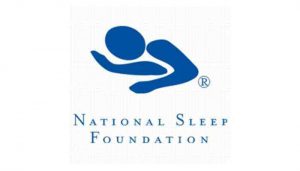 The National Sleep Foundation, along with a multidisciplinary expert panel, has issued its new recommendations for appropriate sleep durations. The report recommends wider sleep ranges for most age groups. A new sleep range, entitled “may be appropriate,” has been added to acknowledge the individual variability in appropriate sleep durations. The NSF’s recommendations now define sleep times as either (a) recommended; (b) may be appropriate for some individuals; or (c) not recommended.
The National Sleep Foundation, along with a multidisciplinary expert panel, has issued its new recommendations for appropriate sleep durations. The report recommends wider sleep ranges for most age groups. A new sleep range, entitled “may be appropriate,” has been added to acknowledge the individual variability in appropriate sleep durations. The NSF’s recommendations now define sleep times as either (a) recommended; (b) may be appropriate for some individuals; or (c) not recommended.
